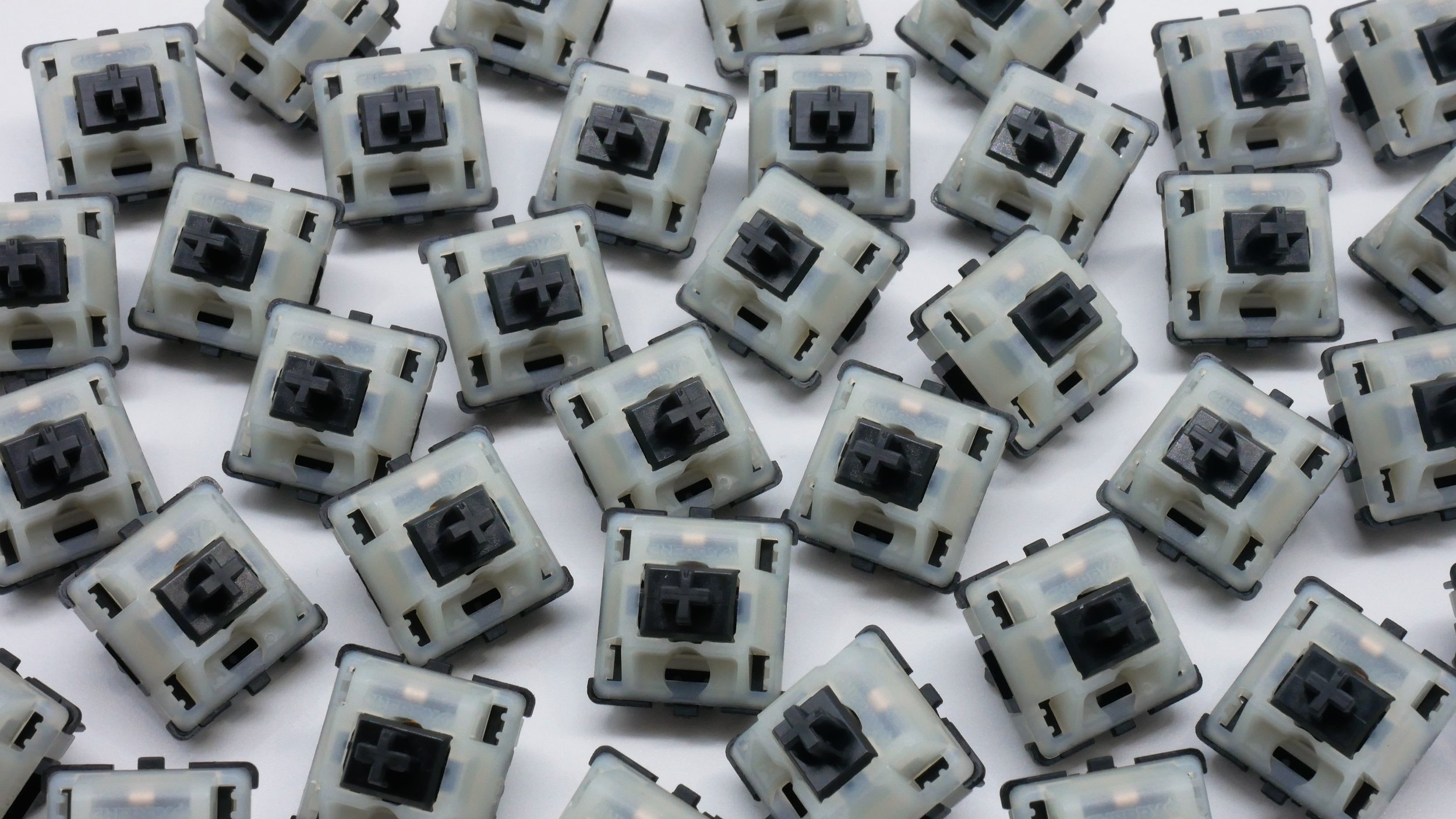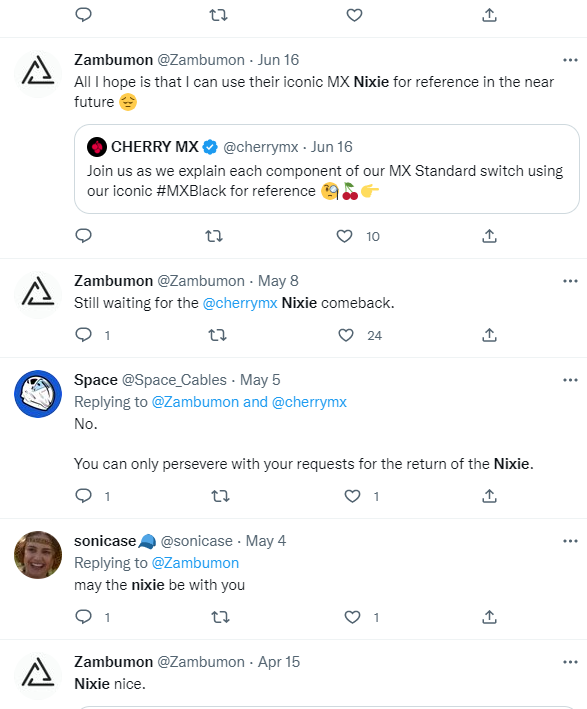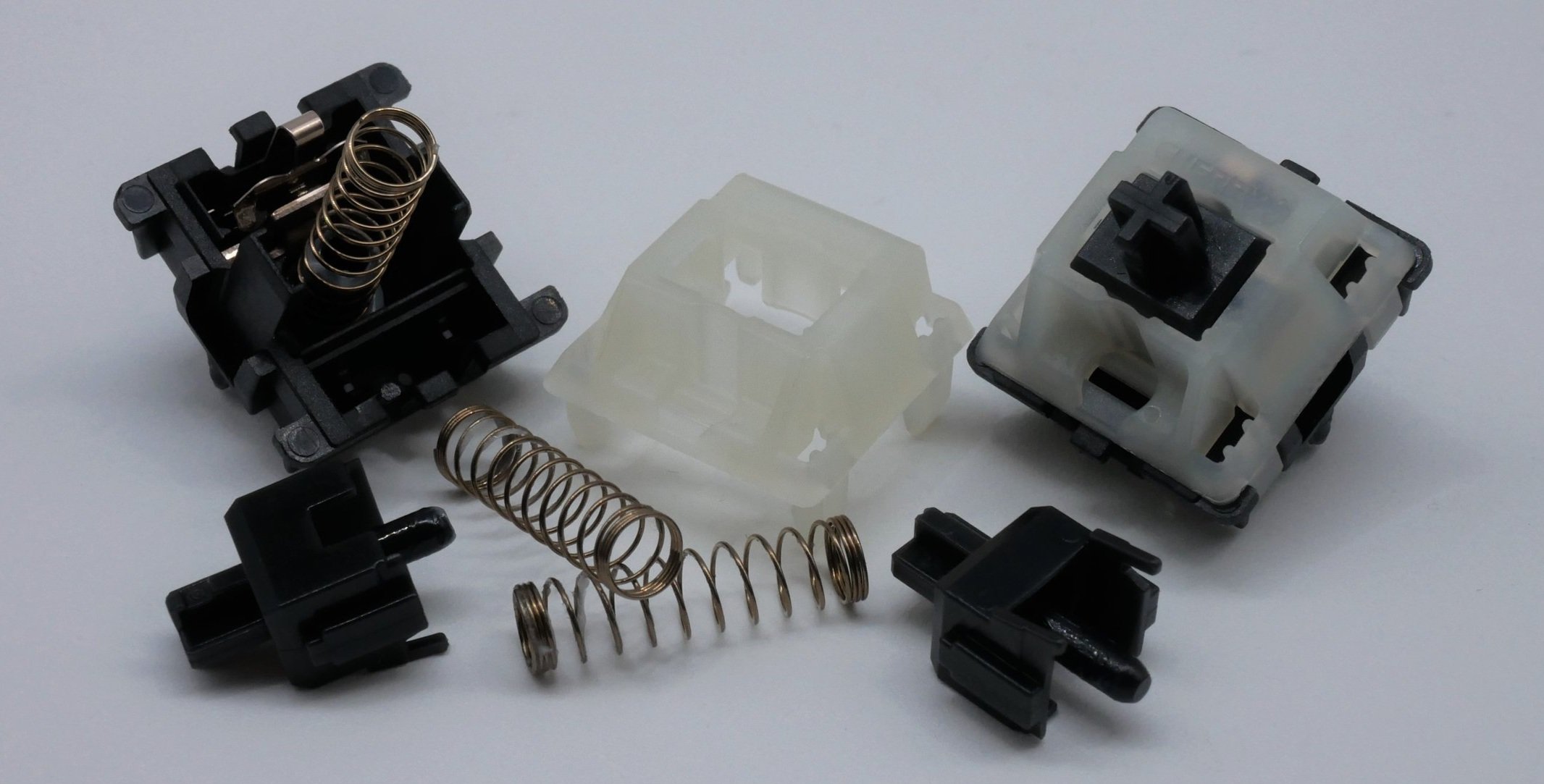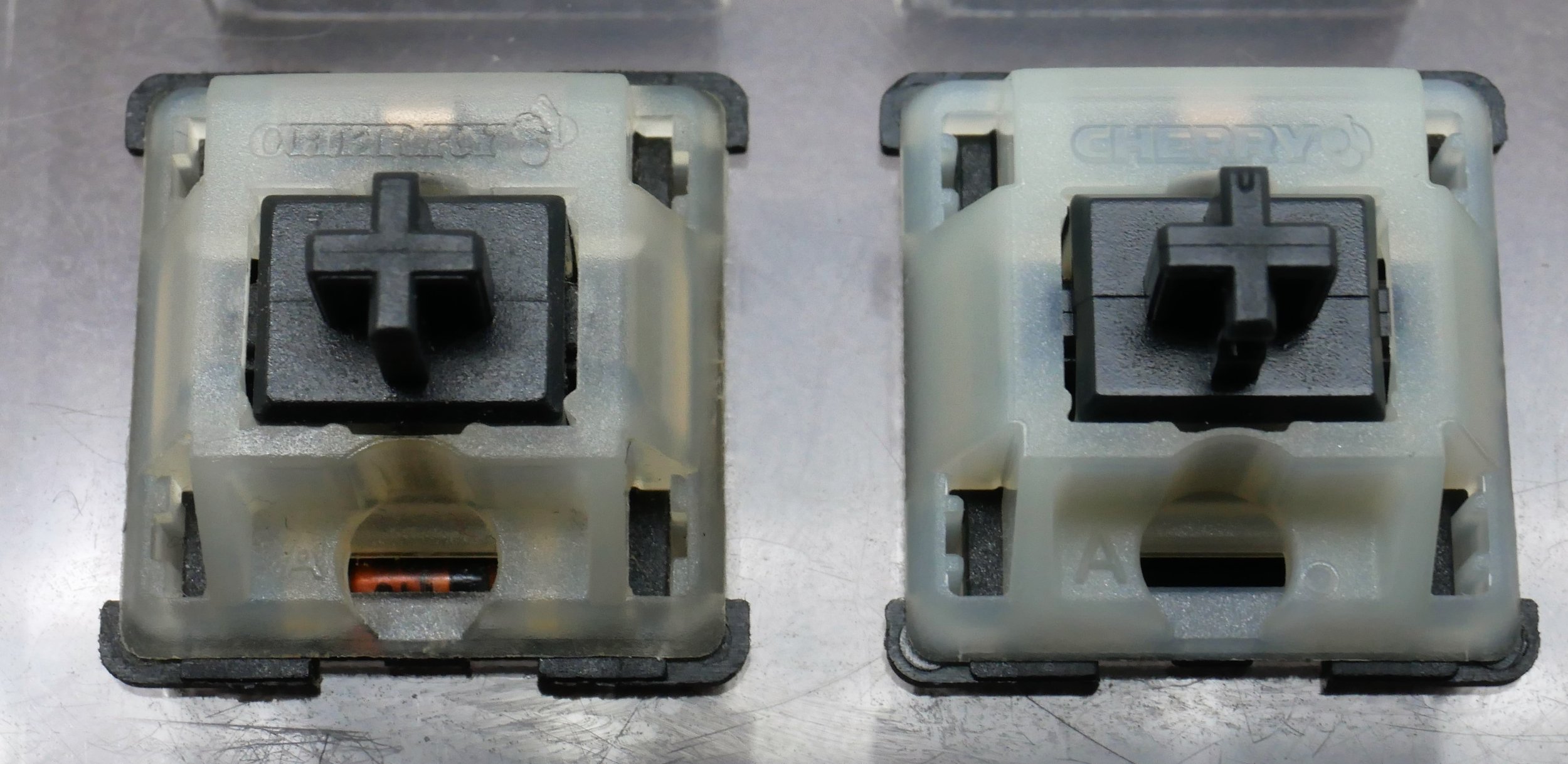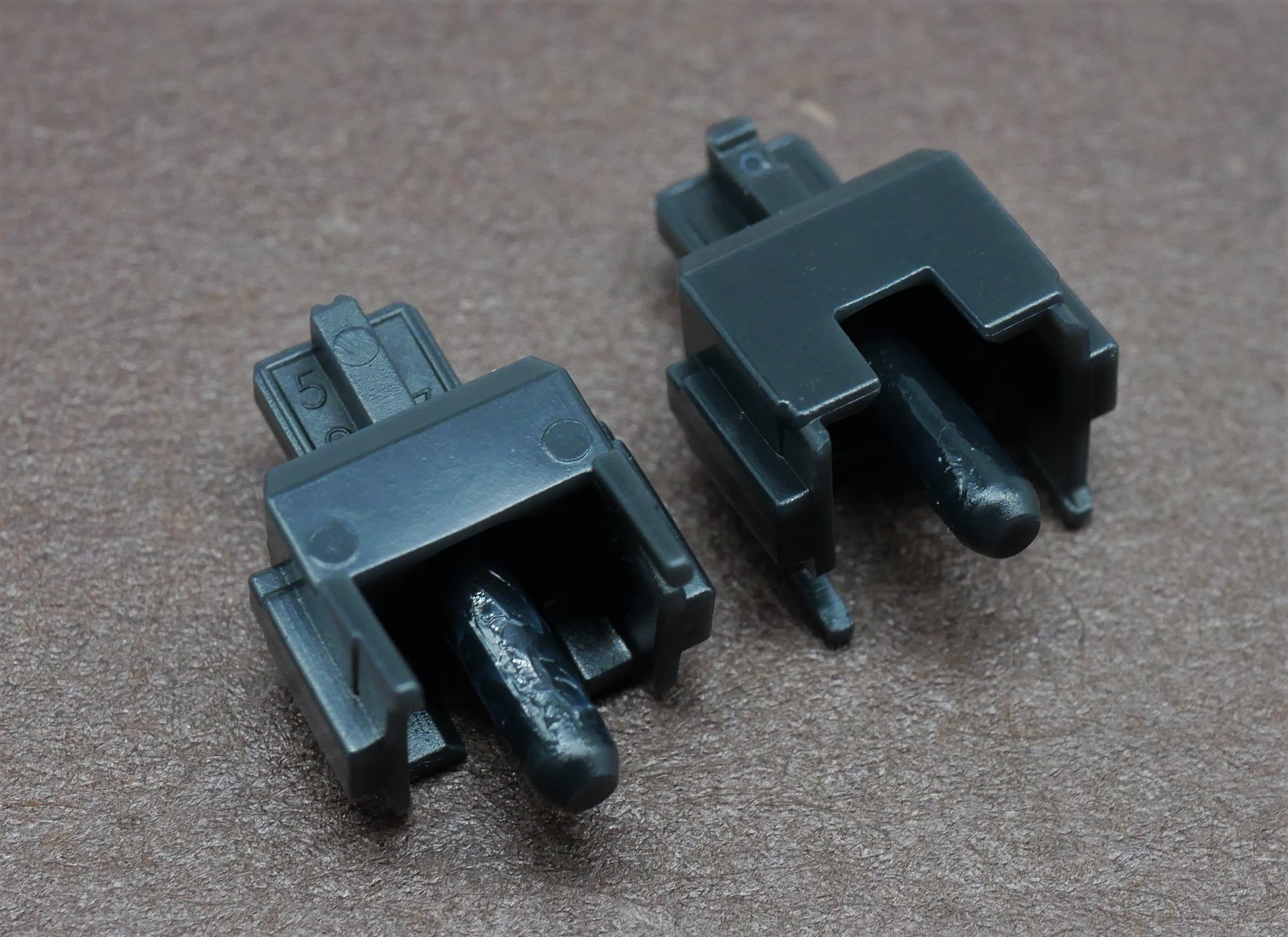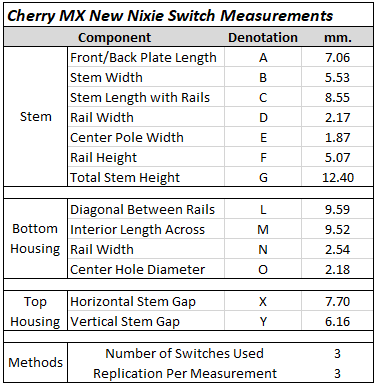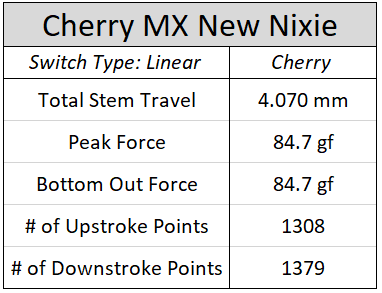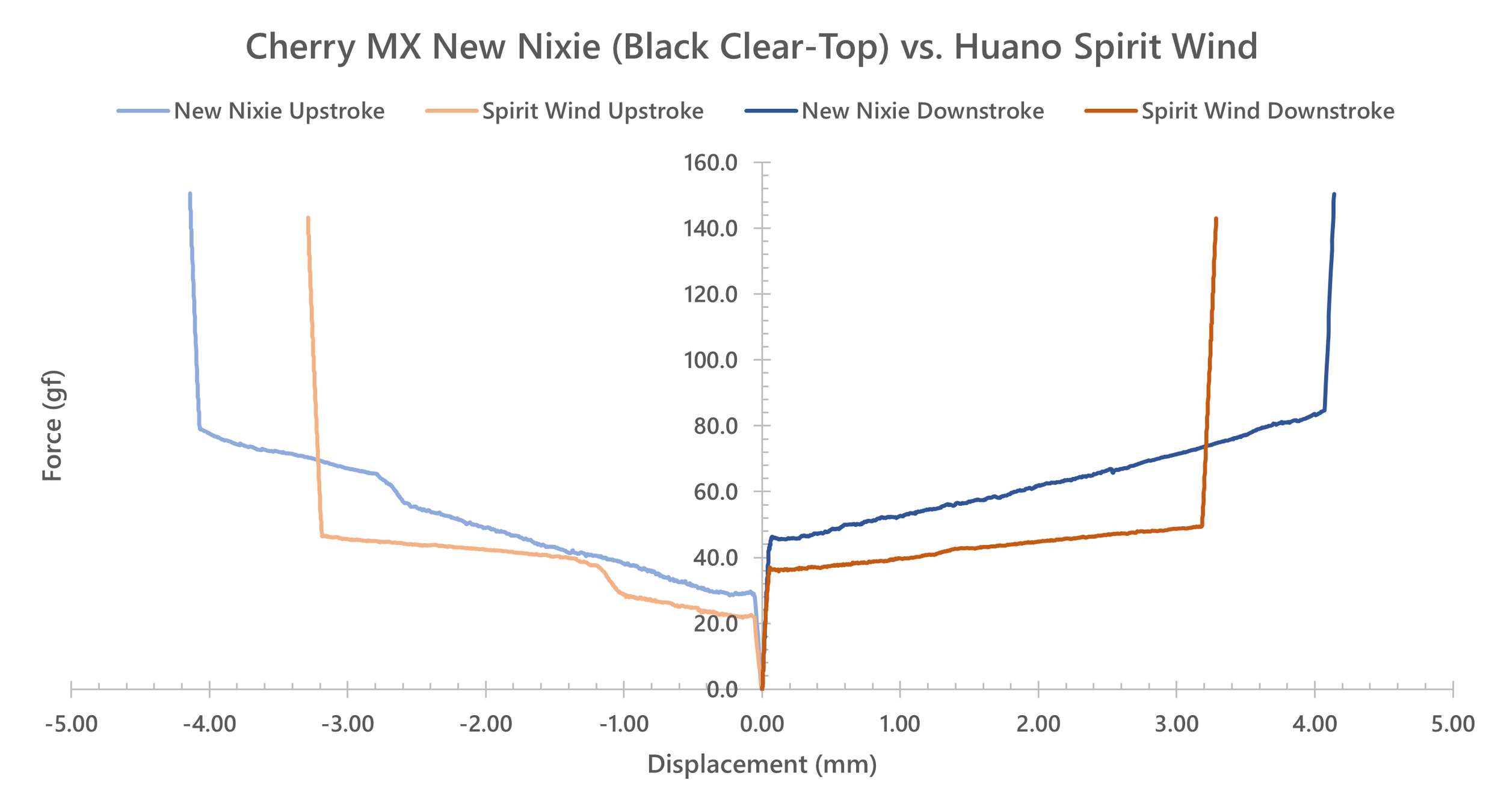Cherry MX ‘New Nixie’ Switch Review
Note: The official name for this switch that it is being sold under is that of the ‘MX Black Clear-Tops’. While I often strive to be technical and accurate in all of my reviews, I know that ‘Nixies’ or ‘New Nixies’ will be the moniker these adopt amongst the community. Thus I will be referring to them as such throughout this review.
So yes, I will admit that I took an extra week off in order to get this review together. I know that this is very uncharacteristic of me as I seemingly like to write as much as possible as frequently as possible, though rest assured that I was trying to make sure that this review turned out perfect. And by perfect, I mean long as all hell. Since I know that my long-winded writing style can be a bit off putting to the Dr. Seuss fans out there, I do want to make it known that I’ve been picking up some side writing projects on other platforms that are a little bit more tractable for newcomers. If you aren’t aware of this new content yet, I would highly recommend checking out Kinetic Labs’ Blog pages as well as Drop’s Guide section as I should be regularly posting there about once or so a month depending on what life has going on for me outside of keyboard-related content. Plus, by checking them out it means Drop and Kinetic Labs are more likely to let me do crazy writing stuff in the future.
Figure 1: Fear and Clacking in Switches
In addition to the content that I do on this website, as well as the aforementioned duo of writing spots I have with Kinetic Labs and Drop, do know that there is still even more content coming from me in the in the coming weeks and months. While neither a week nor month away, tomorrow on December 5th my advent calendar article will be dropping with Kbd.news and I really hope you all will get a chance to check it out, as it talks a bit about the data behind these reviews and what I plan on doing with it moving forward. As well, I know there are some other secret one-off article collaborations being put together behind the scenes with various sites that I just can’t quite tell you about yet. But that being said, thank you all not only for supporting me here on this website but reading and sharing enough to allow me to step out onto those other platforms as well. If it wasn’t for that kind of support, it’s very well likely that I wouldn’t be in this position here today to review these exciting ‘New Nixie’ switches!
Figure 2: And big thanks to Novelkeys for hooking me up with a set so I could check them out!
Switch Background
Leading up to the release of this review and the announcement of these switches by Cherry and every vendor which has had them up for presale, there has been a lot of interest among the community about what exactly is so special about “Nixies” and why everyone else who does know about them is so excited. This excitement wasn’t necessarily just contained to the community, either. In the days following the announcement by Cherry, articles from Arstechnica, The Verge, and quite a few other technology blogs began posting articles effectively quoting Deskthority and my From The Vault: Cherry MX ‘Nixie’ Switch Review as these are some of the very few cohesive pieces of documentation about the boards. That being said though, while the history still remains surrounding these switches as it was established back in the 1980’s, and I highly encourage you to check out my previous article to touch up about those a bit, Nixies have changed quite a bit in the public eye since I published that review on November 7th of 2020.
Well throughout 2020 and 2021, the surge of COVID pandemic-related quarantining and sheltering saw a spike in popularity of the mechanical keyboard scene that has been covered dozens if not hundreds of times over. It turns out, with all sarcasm implied, that people who sit at their desks at home to work and can’t leave and engage in real world activities want to spice up their desk a little bit to make personalized and comfortable. With this surge in popularity, the amount of releases, new product designs, and damn near everything exploded in popularity from within the community. One thing that also exploded, as well, was that of aftermarket pricing. Artisans, keycap sets, and full boards could all be expected to be sold at well over 1.5x their original price almost entirely regardless of wear and tear at that point, and it shot prices for everything – including Nixies – through the roof. In this short time, Nixies jumped from their rough market value of around $7 per switch that I quoted back in late 2020 to $11 at this market peak. However, of all of those products listed before, the original Cherry MX Nixie switches behaved a bit differently.
Figure 3: r/mechmarket circa 2021
After vaccine rollouts and subsequent reemergence of people into the wide world, the aftermarket for mechanical keyboard components rather predictably slew down quite a bit. However, due to the rarity and non-production of Nixie switches, their value has stayed almost steadfast at this $11 per switch valuation, with some more recent sales since Cherry’s announcement being posted (and not bought) at $20 per switch asking prices. It’s worth noting, as well, that this is just for the Cherry MX Nixdorf Blacks, as well. The one-per-board Cherry MX Nixdorf White switches have been being listed at asking prices between $200 and $300 per switch, with the only recent confirmed sale I know of happening last year at $250 for one of these. While I have quite a bit more of a substantial switch budget than most people in the hobby, I’m not entirely certain I could ever justify buying an entire set of these switches at that price and quite frankly it saddens me just a little bit.
Figure 4: I promise you that this tone is my 'sad' tone of voice.
Amidst the chaos that was the 2021 year in mechanical keyboard switches as well, Cherry actually had begun stepping up their community interaction via the main keyboard social media platforms of Twitter and Instagram. (No, I won’t consider TikTok a platform because I’m too old for that.) As early as March 5th of 2021, they had actually teased a render of the original Cherry MX Nixdorf switches sans much context on Twitter with a more devoted message on March 18th to bring them back in some form or another one day. Leading up to the announcement of the new Cherry MX Black Clear-Top ‘Nixie’ switches by Cherry via their social media platforms on November 3rd of 2022, in fact, Cherry made dozens (or some say hundreds) of posts about them hinting and continually prodding the community about their return. Oh wait, I think I messed this last paragraph up. It was actually Zambumon. Zambumon was the one continually posting for the return of Nixies on Twitter.
Figure 5: Turns out it takes...
Figure 6: ... a shit ton of steps ...
Figure 7: ... to get to the top of the mountain.
In all seriousness, rumors and commentary from more inside sources of the community have suggested this project as having been worked on for quite some time between Cherry and larger sized vendors in the community. While I am not entirely certain as to how much influence Zambumon actually had on encouraging this explicit switch to be redesigned, I did feel somewhat inclined to mark his lovingly antagonistic role that he has played leading up to this momentous release on mechanical keyboard Twitter. As well, while I am unable to substantiate this well in this review, I can assure you that this campaign by him certainly did leak out onto other social media platforms based on increased calls by seemingly everyone for the return of Nixies leading up to their announcement date.
First unveiled on November 3rd of 2022, the Cherry MX Black Clear-Top, ‘Nixie’ inspired switches are among the first Cherry switch to be made with the more niche, custom scene in mind in well… basically ever. Boasting extremely similar specs to those of original Cherry MX Blacks, save for the fact that they were offered in pre-lubricated or non-lubricated variants, these switches were stated as being “available worldwide via official distributors starting in 2023.” While an official list of these worldwide distributors was not available to the best of my knowledge, vendors such as Novelkeys, GeonWorks, and Candykeys opened pre-order sales of these “New Nixie” switches starting in late November of 2022 at $0.60 per switch. Pre-order sales were set to end on Christmas day via these vendors with no specific commentary made as to how these planned to be stocked moving into the future. Additionally, the lack of precedent regarding Cherry making niche-oriented switches can only lead to speculation as to how these will be stocked in the future.
‘New Nixie’ Switch Performance
Note: The Cherry MX New Nixie switches come in both lubed and unlubed variants. I was graciously provided a set and only a set of unlubed New Nixies by Novelkeys for my review and thus I can not discuss the factory lubed variants.
Appearance
Figure 8: Cherry MX Black Clear-Top switch and its components.
From a distance, the Cherry MX New Nixie switches look, well, like the original Cherry MX Nixdorf Blacks which evidently inspired them. Coming with a semi-clear, semi-milky top housing colorway, these are among the first produced by Cherry since the 1980’s to feature top housings in this fashion. Sitting atop a black, five pin bottom housing, these switches further deviate from Cherry’s standard practices in that they don’t, to the best of my knowledge at least, appear to have any three pin variants being released in the initial sales posts that end in December of 2022. While Cherry has been arguably constant with respect to their larger switch design features in the modern era, I’m still going to go piecemeal through the component designs to highlight subtle points of note.
Moving first to the top housings of the Cherry MX New Nixie switches, the first thing of striking note when comparing these to the original Cherry MX Nixdorf Blacks is that the housings are not as similar as many people recall. Comparing the opacity of the New Nixies to my Nixdorf White and Nixdorf Black switches below in Figure 9, it’s evident that the newer versions of these switches are actually a slight bit more opaque and milky-like. As well, I would like to note that the difference is much more present in person than in the best photographs I could capture it in. While I unfortunately do not have more than these Nixies in this picture on hand to make that comparison, photographs of original Nixdorf Blacks attached to Softkeys keyboards do appear to corroborate this difference. As well, it’s worth noting that the opacity and general color of the top housing material in the new MX Nixies is not remotely similar to the RGB bottom housings of more recent Cherry MX releases.
Figure 9: Opacity comparison between OG Nixdorf White and Black (Back) and Cherry MX 'New Nixie' (Front).
Figure 10: Color and opacity comparison between Cherry MX 'New Nixie' (Left) and Cherry MX RGB Black (Right).
Externally, the top housings of the New Nixie switches are more or less mundane save for a couple of features. Knowing full well that there will be at least one scam attempted in this fashion on mechmarket here next year, I’m going to note this in all capitals: THE NEW NIXIE SWITCHES ARE THE ONLY “NIXIES” TO HAVE THE MOST MODERN, THICK BUBBLE LETTER CHERRY NAMEPLATES. While these nameplates have begun being streamlined into Cherry MX switches produced throughout the previous year, I suspect that Cherry is making a total change to the use of these newer nameplates and expect it will be quite some time, if ever, before they choose to change the logo again. Beyond the nameplate region, the LED slot design is again similar to that of the original Nixdorf Blacks featuring a relatively constricted rectangular slot set inside of a depressed circle used to support very specific through-hole LEDs. In original Softkeys construction, the diodes used in the board could be seen through this slot, and while these New Nixies are technically capable of replicating such, they do not come with any diodes present. Aside the nameplate history, as well, the feature of interest that stood out to me is that just to the right of these LED slots, on the upper lip there appears to be a small plastic station that serves no purpose but is likely where a mold sprue mark was used in injection molding.
Figure 11: OG Cherry Nixdorf Black (Left) and Cherry MX 'New Nixie' (Right) nameplate comparison.
Figure 12: Cherry MX 'New Nixie' top housing external features including narrow LED slot and milky-opaque color.
Internally, the top housings actually feature a rather commonplace design by all standards with no outright strange architecture that I don’t recall having seen before. That being said, I can’t remember where I’ve seen the 3D, incomplete rectangle like outcropping around the LED slot cut, but I have definitely seen it before in one of these many reviews I’ve wrote throughout the years. The only real point of particular note in the New Nixie top housing internals is the location of the mold marking on the upper left land lip of the housing. Of the switches I’ve received in my batch, all that I cared to open appear to have three-digit mold markings.
Figure 13: Cherry MX 'New Nixie' top housing internals showing fairly standard design features.
Figure 14: Cherry MX 'New Nixie' top housing internal three-digit mold marking.
Checking out the design of the New Nixie stems, next, the overall design features I previously noted in my Cherry MX Brown Switch Review all appear to hold true here as well. The stems come in relatively on the shorter side compared to the other 213 switches I’ve measured at 12.40 mm in total length versus the average of those 213 at 13.00 mm. They also feature no slider rail taper and an ever so slight slope towards the bottom of the center pole that is a bit hard to make out due to the black color of the stem. Working upwards, as is common for Cherry switches, there is a set of small, medium set mold ejector circles on the front plate of the stem. On the backplate, the design is squared off as can be seen below in Figure 15, something of which is particularly uncommon in the modern era of MX switches being produced. Reaching the keycap mount portion of the stem, all stems in the batch that I received appear to have a south side recess with a mold injection point in it that does not in any way interfere with the keycap usage. As well, while the original Nixdorf/Cherry collaboration is distinctly different than that of the Cherry MX Hirose switch line in terms of production and history, it is worth noting that the New Nixies do not have the slight outcroppings in the interior corners of the stems that people have deemed as keycap destroyers in Hirose switches.
Figure 15: Cherry MX 'New Nixie' stems showing marginally tapered slider pole, non-tapered slider rails, and squared off backplate.
While I don’t normally stop to discuss the spring all that often in the ‘Appearance’ section of reviews, I definitely couldn’t help but do it for this one given the marketing point of these springs coming in a ‘golden’ color. Certainly more bronze-ish, coppery than gold, these springs are fairly tightly wound with three compressed rings at either end of the relatively short 15.00 mm span. Whether or not this was intentionally decided upon to pay homage to the original Nixdorf Black and White switches which did occasionally feature a goldish-copper colored spring (as can be seen in my From The Vault: Cherry ‘Nixie’ Switch Review), it certainly does help add an air of authenticity and attention to detail in the designs of these switches. An additional point worth noting in the springs here, which will also appear below in the bottom housing paragraphs, is that the springs appear to have a noticeable amount of lubricant applied to the bottom of the springs where they make contact with the bottom housings. While I am uncertain as to whether or not this appears in both lubed an unlubed variants of the New Nixie switches, I certainly would expect it to show up in the lubed variant since it is here in the unlubed variant as well.
Figure 16: Cherry MX 'New Nixie' freshly opened switch showing minor factory lube application to spring.
Finally arriving to the bottom housings of the Cherry MX New Nixie switches, these wholly appear to be a historically accurate recreation of the original Cherry Nixdorf bottom housings. Looking towards the internals, the mold ejector circles around the upper rim are identically in the same corners as the original switches and the design feature used to hold the diodes in the bottom housing is also present in the LED slot as well. Even the stepped lip design separating the internals of the switch housing where the spring resides and the LED/diode slot region is the same shape as that of the original Nixdorf switches. Externally, the similarities only continue insofar that the switches are 5 pin, carry a diode symbol, single capital letter marking the bottom right-hand corner, and a sideways, three number marking slightly above it. Even the sort of ‘bullseye’ shaped bottom to the center hole also remains, leaving me rather impressed with the attention to detail on these features.
Figure 17: Cherry MX 'New Nixie' bottom housing internal design showing mold ejector circles, lube from the spring, and diode holder in the LED slot.
Figure 18: Cherry MX 'New Nixie' bottom housing external design showing PCB mounting posts and three-digit mold marking in bottom right-hand corner.
Push Feel
I, like many other people both in the hobby and more dedicated to switches specifically, were skeptical as to how the Cherry MX New Nixies would turn out in terms of their straight up, in-hand performance. As we’ve seen an explosion in new manufacturers and improved manufacturing techniques over the last handful of years, our expectations have begun to be set pretty high as to what exactly makes a good linear switch. Tempering those expectations a bit, I do want to remind everyone that to the average hobbyist who is in deep, newly minted Cherry MX switches often come quite scratchy and require a rather substantial amount of aftermarket modifications to bring them up to par with other switch options – be it by some lubrication, breaking in, or some combination thereof. To that end, I think that any ability by Cherry to narrow this gap that is required to bring their switches from their spec to a sort of ‘hobbyist spec’, if you will, would bring about a rather drastically improved opinion of them by the community at large.
With that perspective in mind, the Cherry MX New Nixies have definitely narrowed the gap with respect to scratch a lot more than anyone may have initially anticipated. Even though the Cherry MX New Nixies have a decent amount of scratch that is noticeable in their stock form, it is not only more significantly fine than that of previous batches of Cherry MX linears that I’ve tried, but as can be seen in the ‘Break In’ section below, this wears away insanely fast by comparison. Rather than breaking in switches as well, less thorough and quicker aftermarket lubrication can improve these switches drastically as compared to other, more common Cherry linears. An additional point which was nice to see regarding the smoothness in the Cherry MX New Nixies is that they also are rather consistent with respect to this scratch across the large batch that I received. While this is obviously bound to change somewhat given the massive amount of these switches which will be produced via these molds, I would argue that the batch wide variability in scratch is surprisingly no more or less of an issue than any other more niche-focused manufacturers.
With respect to the housing collisions in the Cherry MX New Nixie switches, I don’t think that the change from the standard Cherry expectation is as cleanly cut as the aforementioned improvement to smoothness. On the positive end of things, the Cherry MX New Nixie springs have done a damn fine job of replicating the feeling and force curves of Cherry MX Blacks, something which is not only evident by their roughly 85 gf bottoming out weight, but their near identical force curves as can be seen below in the ‘Switch Comparison’ section. This, in turn, leads to a relatively firm and muted feeling bottom out that is expected of Cherry’s nylon housings, though perhaps ever so slightly thinner than I remember having tried previously. On the other side, though, the milky-top housings in these New Nixies are definitely different than their all-black, all-nylon counterparts. Whether it is a difference in mechanical thickness or material used to make these top housings, the topping out is a bit more thin, pointed, and similar to that of an ‘RGB’ like top housing. Again, though, upon breaking these switches in a bit this intensity and sharpness to this topping out mellows quite substantially.
Figure 19: Cherry MX 'New Nixie' complete force curve diagram.
Sound
Starting yet again with the expectations of Cherry switches in this section, I want to remind everyone of the stock spring ping that appears to be present in most of Cherry’s common linear offerings. While this is especially more notable in their tactiles and clickies, even in the linear switches Cherry’s springs have a bit of a reputation for being loud and providing metallic undertones to their switches’ sound that highlights all the wrong aspects of them. However, with the very minor lube application to the bottom of the springs in these New Nixie switches, it is almost as if this was never an issue in the first place. Close to none of the switches I received in my batch had spring ping issues out of the box, and those that did were significantly more subtle than that of the comparable Cherry MX Black switch that could be bought today. This, alone, had me really excited when testing these switches immediately after ripping open the package that they came in.
As for the rest of the actual switch’s sound profile, it is fairly in line with my descriptions previously laid out in the ‘Push Feel’ section above. Immediately out of the box, the Cherry MX New Nixies have a subtle scratch undertone that is packed in between a fairly muted, firm toned bottoming out which is overshadowed by the thinner, plasticky topping out sound. Without any aftermarket modifications, all of the rougher edges to this sound – such as the plastic-like tones in the topping out and the small grain scratch – all but disappear into a significantly more well-rounded and cohesive linear switch. Immediate aftermarket modification sans breaking in, as well, does well to round out these sharp edges a little bit as well as decrease the overall volume from its original medium-loud setting.
Wobble
I, yet again, want to caveat the beginning of this section by pointing out that due to the sheer quantity of these switches that Cherry will likely produce moving forward this sort of metric described here is very likely to change and morph over the long run. Given that I have one of the first batches out of the gate, however, I can only speak to what I have in front of me so if you’re reading this upset in 2023, put the pitchforks away. With that fourth wall-breaking plea for protection, I will have to say that the wobble improvements are bar none one of the most impressive things that I’ve seen improved in the Cherry MX New Nixie switches. Sure, having smoother Cherry switches without any spring ping out of the box is great, but these are a night and day difference versus what I’ve seen across the board with stock Cherry switches in terms of stem wobble.
The Cherry MX New Nixies have very little wobble in the E/W direction and even less in the N/S direction. While perhaps not up to the absolute pinnacle of wobble performances, its likely enough that this won’t bother the majority of the users in the hobby and that they would put it on par with expectations from larger niche manufacturers such as Durock/JWK and Tecsee. Additionally, none of the switches in my batch had any top housing wobble and thus appeared to have very well-tuned tolerances with respect to these features. The final extra bit of magic that led to my surprise in testing these switches out the first time is just how much these wobble metrics were consistent across the large-ish size batch of switches I received. Much like that comment I made above regarding consistency in the New Nixies on par with expectations and practices from more niche-oriented manufacturers, I would say that the wobble is at least at that level of consistency if not slightly past it in the batch that I received.
Measurements
If you’re into this level of detail about your switches, you should know that I have a switch measurement sheet that logs all of this data, as well as many other cool features which can be found under the ‘Archive’ tab at the top of this page or by clicking on the card above. Known as the ‘Measurement Sheet’, this sheet typically gets updated weekly and aims to take physical measurements of various switch components to compare mold designs on a brand-by-brand basis as well as provide a rough frankenswitching estimation sheet for combining various stems and top housings.
The latest in the content-adjacent work that I’ve picked up, the new ‘Force Curve Repository’ is now hosted on GitHub alongside the Scorecard Repository and contains all force curves that I make both within and outside of reviews. In addition to having these graphs above, I have various other versions of the graphs, raw data, and my processed data all available for each switch to use as you please. Check it out via the ‘Archive’ tab at the top of this page or by clicking any of the force curve cards above.
Break In
Break In Notes
Note: Again, given the special nature of this review I couldn’t just stop at 3 hours of break in time. Instead, I did a full 8 hour set of break in testing with hour splits as per normal.
17,000 Actuations
- I’m rather incredulous at just how well these switches have changed their smoothness after only one hour of breaking in on my machine. Both the sound of and overall physical feeling of the scratchiness was reduced, making it among one of the quickest to improve on such metrics I’ve ever seen in this testing.
- Unlike convention, the stem wobble does not appear to have changed significantly enough in the Cherry MX New Nixies after just 17,000 actuations to justify a change. While I think some have slightly increased in wobble, when averaged across all of the switches broken in this far I just can’t see enough of a difference to change the rating.
34,000 Actuations
- Even though they fought valiantly for one hour of testing, after 34,000 actuations there is a slight bit of N/S direction stem wobble increase, though it is still well below what is commonly expected in terms of wobble from Cherry MX-produced switches.
- One interesting note regarding the sound is that in addition to the reduction in scratch sound still being present, I swear that these switches have a less plasticky, more robust sounding topping out. While I may be willing to waffle on this point a bit, it definitely does appear clearly to my ears at 51,000 actuations.
51,000 Actuations
- More or less, the same features noted at 34,000 actuations also hold true after three hours of break in (51,000 actuations). The point mentioned above regarding the deepening of the topping out sound becomes especially more prevalent here and I’m willing to accept it here that I am not in fact losing my mind.
- While perhaps this is slightly more harsh of me than I normally am with break in testing, this is the very first instance where I just barely could here spring ping in some of the switches beyond that of stock variability. That being said though, this is almost so minor that I am being a bit critical in giving a minus sign this early on in their break in testing.
68,000 Actuations
- As compared to stock Cherry MX New Nixie switches, this is the minimum point I feel that you should intend to break your switches in in order to get a pretty distinct difference from their stock form. That being said, there is still a few stages of improvement beyond this point that might be worth heading towards if you’ve got the time.
- Again, the incredibly subtle spring ping is present here as it was at 51,000 actuations, though again I wish to stress that this is both rather minor and hardly any more present at this stage than it was at the last one.
85,000 Actuations
- This is the first stage since the initial breaking in to 17,000 actuations in which the smoothness really does start to differentiate itself. While it may be only minorly better than that of the 68,000-actuation set, as compared to the stock New Nixies its incredibly just how well these ‘age’ in the break in machine over time.
- The other points noted above in previous stages of breaking in regarding the stem wobble and overall improvement to sound in the Cherry MX New Nixie switches holds true here when comparing these to the stock variants.
102,000 Actuations
- Interestingly, this is the point that I really believe the stem wobble, specifically in the E/W direction, begins to become a bit more noticeable before. Unlike my harshness with respect to the spring ping noted previously, I may be willing to concede that this started appearing at 85,000 actuations, though it was incredibly borderline whether or not it was deserving of that step down in terms of performance.
- Regarding the subtle spring ping point, while there does not appear to be any more switches on average which have this feature at 102,000 actuations (around 25% or so at maximum), the switches that it does appear in have it slightly more noticeably than what was noted in previous actuations.
119,000 Actuations
- Again, the relatively coarse sizing of my rating system here makes it really hard to catch some of the nuances I see happening at these time steps. Specifically regarding the topping out of the Cherry MX New Nixie switches, they appear to be gaining a sort of ‘stickiness’ that simply wasn’t present at previous time steps. That being said, aftermarket lubrication more or less appears to remove this issue in entirety.
- The other points noted in previous steps regarding all of the other features also appears to hold true at 119,000 actuations.
136,000 Actuations
- I suspect that this is the point at which diminishing gains really begins to kick in without much room for argument. At 136,000 actuations, these switches are damn near impossible to differentiate from the 119,000-actuation set blindly and I suspect any differences that can be noted are entirely placebo at this point.
Comparison Notes to Other Notable Linear Switches
Note – These are not aimed at being comprehensive comparisons between all factors of these switches as this would simply be too long for this writeup. These are little notes of interest I generated when comparing these switches to the New Nixies switches side by side.
Figure 24: Switches for Comparison. (L-R, Top-Bot: Novelkeys Dream Cream, Invokeys Black Sesame, RAMA WORKS Duck, TTC Tiger, Obsidian Pro, Gateron Oil King)
Novelkeys Dream Cream
- While both switches have some degree of scratch to them, the scratch that is present in the New Nixie switches is not only a bit more prevalent in terms of overall feeling but also ever so slightly finer in grain.
- The housing collisions, and especially those of the topping out of the Dream Creams is thinner and slightly more plasticky feeling than that of the Cherry MX New Nixies.
- In terms of stem wobble, the New Nixie switches have the greater E/W direction stem wobble and the Dream Creams have the greater N/S direction wobble by a slim margin.
Invokeys Black Sesame
- Surprisingly contrary to my initial guesses, the Cherry MX New Nixies have a noticeably less firm, solid, and punctuated bottom out than that of the Invokeys Black Sesame switches.
- While the Black Sesames definitely edge out the New Nixies in terms of E/W stem wobble, their N/S direction stem wobbles are actually fairly comparable all things considered.
- In terms of overall sound, the Invokeys Black Sesames are both louder in terms of total volume and carry a deeper pitch than that of the New Nixie switches.
RAMA WORKS Duck
- When considering the premise of a ‘re-designed switch boasting mass community support and showing actual innovation over existing products to justify a reasonable price hike’, the RAMA WORKS Ducks don’t stand a chance against the Cherry MX New Nixies.
- While both topping outs between these two switches are similar in terms of their thinness in feeling, the New Nixies sound ever so slightly more fragile and plasticky than that of the Ducks.
- In terms of smoothness, the new Gateron factory lubrication in the Ducks obviously beats out the unlubed nature of any Cherry MX switches, regardless of their general improvements or not.
- In terms of stem wobble, these two switches are fairly comparable with perhaps the Ducks ever so slightly edging out the New Nixies in terms of E/W direction stem wobble.
TTC Tiger
- Not only are the TTC Tigers overall more louder and higher pitched sounding at the topping out than the Cherry MX New Nixies, but their sound is also much more singular and focused to a point than the broader sound of the New Nixies.
- The TTC Tiger switches, both OG and Regular (even though only the regular version are actually being compared here otherwise) are smoother throughout their stroke than the New Nixie switches.
- In addition to the comment regarding how the housing collisions sounding more singular and pointed in the Tigers as compared to the new Nixies, the bottom outs also feels ever so slightly more abrupt and less cushioned. It is almost as if the bottom housing material of the TTC Tigers is more stiff than that of the New Nixies.
Obsidian Pro
- While this is a tad bit hard to pin down, the Obsidian Pro switches have an ever so slightly more ‘metallic’ sound to them than that of the New Nixies. That is not to say that either of these switches have spring ping in their stock form, rather I think that the stem and leaf interaction in the Obisdian Pros is a bit more forceful.
- Especially at higher actuation speeds, the Obisdian Pros top out and bottom out with significantly greater volume than that of the Cherry MX New Nixies.
- While true in both directions, the New Nixie switches especially outpace the Obsidian Pro switches with respect to their E/W direction stem wobble.
Gateron Oil King
-To the surprise of absolutely nobody who has tried the Gateron Oil Kings before, the 2022 improved lubricant application by Gateron makes these switches infinitely more smooth than stock, unlubed Cherry MX switches.
- Interestingly, out of this initial set of switch comparisons, these two switches actually are the most comparable to each other in terms of overall volume. The Oil Kings, though, are slightly less plasticky and higher pitched at topping out.
Comparison Notes to Other Notable Linear Switches Part 2
Note – These are not aimed at being comprehensive comparisons between all factors of these switches as this would simply be too long for this writeup. It’s not every day that you get to review a switch this highly anticipated by the community, so I thought it would be worth it to go twice as hard on the comparisons for this one.
Figure 31: Switches for comparison 2: Electric Boogaloo (L-R, Top-Bot: KTT Custard, Cherry MX Black, Cherry Nixdorf Black, Chocolate Toffee Linear, Huano Spirit Wind, Akko V3 Cream Yellow)
KTT Custard
- These two switches are quite similar to each other in terms of their scratch feeling. I would say though that the New Nixie switches’ scratchiness is just a tiny bit more prevalent in the overall push feel and smaller grain in size.
- The KTT Custard switches, in the few that I have here for testing, appear to have a subtle spring ping or general metallic sound to them that is simply absent from the New Nixie switches which I’ve tested.
- While the bottoming out between these two switches is fairly comparable, the topping out is thinner and more plasticky feeling and sounding in the Cherry MX New Nixie switches.
Cherry MX Black
Note: Cherry MX Blacks come in all different varieties due to both their longevity of production and variability in tooling throughout the years. Your mileage may very regarding this comparison.
- Surprisingly, the efforts behind the scenes by Cherry in these New Nixie switches do appear to have slightly improved with respect to smoothness as compared to an MX Black that was produced circa 2018.
- Unlike the specific MX Blacks used in this comparison here, as well as my broad experience with Cherry switches as a whole, the New Nixies surprisingly don’t have any spring ping to them.
- The milky top housing of the New Nixie switches does contribute to a louder, thinner, and more aggressive sounding topping out than that of the original Cherry MX Blacks.
Cherry MX Nixdorf Black
Note: The same comment regarding to MX Blacks above also applies to original MX Nixdorf Blacks. Mine may be better than yours, and thus your mileage may vary regarding this comparison.
- Of all of the switches in either of these comparison sets, these two switches are the most comparable to each other in terms of overall scratch presence as well as scratch size throughout the stroke.
- Whereas the original Nixdorf Blacks are more likely to suffer from spring ping than that of the New Nixie switches, the OG Nixdorf Blacks do have a slightly deeper and more firm topping out sound.
- At least when compared to my Nixdorf Black switch, the stem wobble is fairly comparable between these two switches. If I really had to pick an absolute champion, the OG ones edge out the New Nixies ever so slightly in the N/S direction.
Chocolate Toffee Linear
- While these two switches share similar scratch to each other in terms of size, the New Nixie switch scratch is just the tiniest bit more noticeable than that of the Chocolate Toffee switches.
- The Cherry MX New Nixies slightly edge out the Chocolate Toffee Linears with respect to N/S direction stem wobble. Interestingly, though, the Chocolate Toffee Linears edge out the New Nixies with respect to E/W direction stem wobble.
- At the upper end of normal typing speeds, the Chocolate Toffee Linears are overall much more loud than the New Nixies in terms of housing collisions.
Huano Spirit Wind
- The housing collisions, both topping and especially bottoming out, in the Huano Spirit Wind switches are more firm and pointed feeling than that of the Cherry MX New Nixies.
- Surprisingly as well, even with the improved tolerances in the Cherry MX New Nixie switches, the Huano Spirit Winds still edge them out in both N/S and E/W direction stem wobble.
- With respect to overall volume, at literally any typing speeds the Huano Spirit Winds are significantly louder and more in your face than that of the Cherry MX New Nixie switches.
Akko V3 Cream Yellow
- While these switches are quite similar to each other in terms of overall volume, the bottoming out of the Akko V3 Cream Yellows is deep enough to produce a noticeable difference between these two switches at that point.
- The Cherry MX New Nixies pretty handily outclass the Akko V3 Cream Yellow switches in terms of stem wobble in both directions.
- There is a subtle, somewhat hard to pin down ‘stickiness’ in the Akko V3 Cream Yellow switches that stands out as a bit odd and offbeat when compared to the Cherry MX New Nixies which are more or less perfectly in line with the expectations of their construction and design.
Scores and Statistics
Note – These scores are not necessarily completely indicative of the nuanced review above. If you’ve skipped straight to this section, I can only recommend that you at least glance at the other sections above in order to get a stronger idea of my opinion about these switches.
Push Feel
This is perhaps the singular scorecard which has made me question my decision to not include break in notes in the overall scores. That being said, out of the box the Cherry MX ‘New Nixies’ are an all-around improved version of the average Cherry linear. Very small grain scratch size as well as a firm, muted bottoming out are on par with the average linear switch as of the time of this review, with the slightly less firm, plasticky topping out providing a bit of a different feel.
Wobble
The wobble, both in terms of single-switch and batch-wide performances is quite damn impressive by Cherry. Little stem wobble in the E/W and even less in the N/S direction provides an experience that very few if anyone in the community would likely have an issue with.
Sound
While Cherry has done well to remove their classically expected trait of spring ping via the addition of a slightly lubed spring base from the factory, the out of the box sound is still a bit marred from the thinner topping out and scratchy sound. These definitely sound like a lighter, less robust and developed Cherry MX Black out of the box.
Context
Priced at a pretty reasonable for time of release $0.60 per switch, these have all the making of a cornerstone, history defining moment in switch history. Their widespread stock, insane community hype, and momentous release from a manufacturer who hasn’t engaged the niche hobby like this ever before will likely see hundreds upon thousands of custom boards built with these switches in the years to come, even if they aren’t the absolute best performing switches.
Other
The hype buildup, the noted deliberate improvements by Cherry, and the first of a kind engagement with the community makes these switches ones that won’t be forgotten. I can’t think of any switch, any release, or any story as big as this has been in switch history.
Historical Note: This is the first time that any switch has received a perfect score in any category via my reviews.
Statistics
If you are looking at this statistics section for the first time and wondering where the hell are the other 208 switches that I’ve ranked are, or what ‘hard’ versus ‘soft’ ranks refer to specifically, I’d encourage you to head on over to my GitHub linked in the table above or at the links in the top right hand of this website to check out my database of scorecards as well as the ‘Composite Score Sheet’ which has a full listing of the rankings for each and every switch I’ve ranked thus far.
Final Conclusions
All things considered, the anticipatory build up to and actually getting to test these Cherry MX Black Clear-Top ‘New Nixie’ switches has been some of the most fun I’ve ever had with switches in my all-too-long career of reviewing them. As alluded to in their Context and Other scores on their scorecard, these switches are quite frankly the most highly anticipated and exciting collaboration I can think of with switches that has the community at large more excited than not. Sure, one could definitely make the claim that events such as Stealios, the release of Zealios V2 switches, and the releasing of market pressure on Holy Pandas all were significant events in the history of switches that garnered a lot of attention, but this has been far and away the most positive of those experience. Keeping that in mind, alone, makes it hard not to be excited about these switches and any improvements Cherry could have possibly made over their standard linear releases in the previous decade or so.
With that build up in excitement in mind, it’s easy to point to the positive that Cherry delivered on. They not only improved their smoothness in their switches, a key feature in any linear switch, but they also deliberately and successfully removed spring ping and a significant amount of stem wobble from these New Nixie switches that makes them finally competitive with more niche releases with respect to those metrics. Unintentionally as well, these features only seem to really improve with usage or modification, making this already good steppingstone for Cherry MX New Nixies into the future the start of a potentially long-winding path of community appreciation. That being said, though, these are by no means a perfect switch. In the unlubed Cherry MX New Nixies, there is still some amount of scratch and topping out thinness/plastic like nature that could initially be too hard for some hobbyists to overlook in pursuit of that more toned down, broken in feeling. As well, general concerns moving into the future regarding how consistent these switches will stay under massive quantities of production is not only a fair concern, but one that is well motivated by Cherry’s historical nature with their switch production.
Unlike many switches I’ve review on this site and in my way-too-long content form, I can unequivocally say that these have more potential than any of the switches that I’ve reviewed to be a staple within the community. At no discount to the performance and marketing of those that came before the New Nixies, the sheer reach and brand-recognition that Cherry MX brings to the table matched with noted improvements in these switches just drums up a level of excitement that can’t be beat. So long as Cherry continues to dot their ‘i’s and crosses their ‘t’s in the months leading up to and following the release and continual manufacturing of these New Nixie switches, I could imagine meetup scenarios in the future in which a large number of boards could have these switches, not unlike that of when Zealios switches first released back in the day. The sky is really the limit with these switches, and while they may not be the best out of the box linear that I’ve ever seen, you can be damn sure I’m picking up (another) pack of them so I don’t get a chance to miss out on this historical switch release.
Sponsors/Affiliates
Mechbox UK
- A wonderful UK based operation which sells singles to switches that I’ve used above in my comparisons for collectors and the curious alike. Matt has gone out of his way to help me build out big parts of my collection, and buying something using this link supports him as well as my content!
KeebCats UK
- A switch peripheral company based out of the UK which sells everything switch adjacent you could ask for, they’ve been a huge help recently with my film and lube supply for personal builds, and they want to extend that help to you too. Use code ‘GOAT’ for 10% off your order when you check them out!
proto[Typist] Keyboards
- An all-things keyboard vendor based out of the UK, proto[Typist] is a regular stocker of everything from switches to the latest keyboard and keycap groupbuys. While I’ve bought things from the many times in the past, they also are a sponsor of my work and allow me to get some of the great switches I write about!
MKUltra Corporation
- We may have stolen a few government secrets to get this one together. MKUltra is a US vendor that truly fills all the gaps other vendors simply don’t offer and is continuing to expand their switch and switch related peripherals by the day. Use code ‘GOAT’ for 5% off your order when you check them out!
Divinikey
- Not only do they stock just about everything related to keyboards and switches, but they’re super friendly and ship out pretty quick too. Divinikey has been a huge help to me and my builds over the last year or two of doing reviews and they’ll definitely hook you up. Use code ‘GOAT’ for 5% off your order when you check them out!
ZealPC
- Do they really need any introduction? Zeal and crew kicked off the custom switch scene many years ago with their iconic Zealios switches and the story of switches today couldn’t be told without them. Use code ‘GOAT’ (or click the link above) for 5% off your order when you check them out!
MechMods UK
- A rising vendor based in the UK, Ryan and crew have been a pleasure to work with and have nearly everything you’d need to build your first or fourteenth keyboard. Go build your latest or greatest one right now with them by using code ‘GOAT’ at checkout for a 5% discount!
Dangkeebs
- A longtime supporter of the website and the collection, Dangkeebs has quite possibly the widest variety of switches of any vendor out there. Not only is their switch selection large, but it rotates and is constantly adding new stuff too. You’re going to need 5% off your order with my affiliate to save off the cost of all those switches!
SwitchOddities
- The brainchild of one my most adventurous proxies, SwitchOddities is a place where you can try out all the fancy, strange, and eastern-exclusive switches that I flex on my maildays with. Follow my affiliate code and use code ‘GOAT’ at checkout to save 5% on some of the most interesting switches you’ll ever try!
Cannonkeys
- Does anybody not know of Cannonkeys at this point? One of the largest vendors in North America with keyboards, switches, keycaps, and literally everything you could ever want for a keyboard always in stock and with an incredibly dedicated and loving crew. Follow my affiliate link above in their name to support both them and I when you buy yourself some switches!
Kinetic Labs
- One of the most well-rounded keyboard vendors out there, Christian and crew have been supporters of all my switch and switch-adjacent needs for some years now. I’m honored to have them as an affiliate and think you should check them out using my affiliate link above to support both them and I when you check out their awesome products!
Further Reading
Cherry’s MX Black Clear-Top Description Page
Cherry MX Black Clear-Top Spec Sheet
Novelkeys’ Cherry MX Black Clear-Top Preorder Sales Page
GeonWorks’ Cherry MX Special Switches Preorder Page
Candykeys’ Cherry MX Black Clear-Top Switch Preorder Page
Arstechnica Article on Cherry MX Black Clear-Top Switches
LightningXI’s KMAC Happy with New ‘Nixies’ Build Stream

